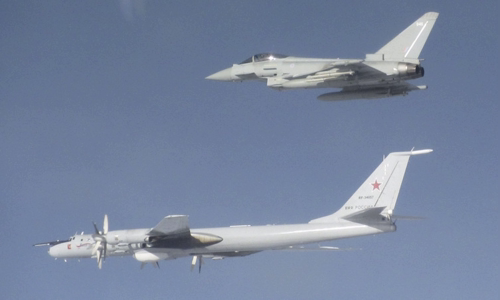MiG-31 fighters flew in the face, preventing F-16 and F-35 Norway fighters from crashing Tu-142 Russian hunting planes in international airspace.
The Russian Defense Ministry on March 8 released a video shot from the cockpit of the Tu-142MK underground hunting plane during a long-range patrol a day earlier, showing the process of confrontation between Russian aircraft squadrons and British fighters, Norway.

British Typhoon fighter (top) watched the Russian Tu-142MK on 7 March Photo: RAF
In the video, British multirole Typhoon fighters, F-16 and F-35 Norwegian fighters approach the border, including Tu-142MK underground hunting aircraft and Tu-142MR communication aircraft of the Russian Navy. .
As European fighters tried to get close, a Russian MiG-31 heavy-duty fighter with long-range missiles suddenly appeared, speeding up the face-to-face to "ballast", warning them not to get any closer. Tu-142MK aircraft.
The Russian Northern Fleet previously announced that two Tu-142s had flown over international waters in the Barents Sea, the Norwegian Sea, the North Sea and the Atlantic Ocean as NATO prepared to conduct drills in Norway. .
The Russian Ministry of Defense confirmed that the flights comply with the rules of international airspace. The British Air Force said the confrontation was "a routine operation in collaboration with NATO allies".
The Tu-142 is a Soviet long-range submarine and reconnaissance aircraft based on the Tu-95 strategic bomber platform. The deep-upgraded Tu-142MK is equipped with a variety of modern sensor systems to detect submarines, along with the radar system and guided missiles for cruise missiles.
Each Tu-142MK aircraft has a combat radius of 6,500 km, carrying up to 9 tons of weapons including water buoys, torpedoes, torpedoes and anti-ship cruise missiles Kh-35. The ability to detect and destroy many types of submarines has made it known as the "underground killer" of the Russian naval air force.
The Tu-142MR is a VLF radio frequency relay version that functions similar to the US E-6A TACAMO model. It ensures communication between the headquarters and the strategic nuclear submarines operating offshore.



 AmandaHudson
AmandaHudson







